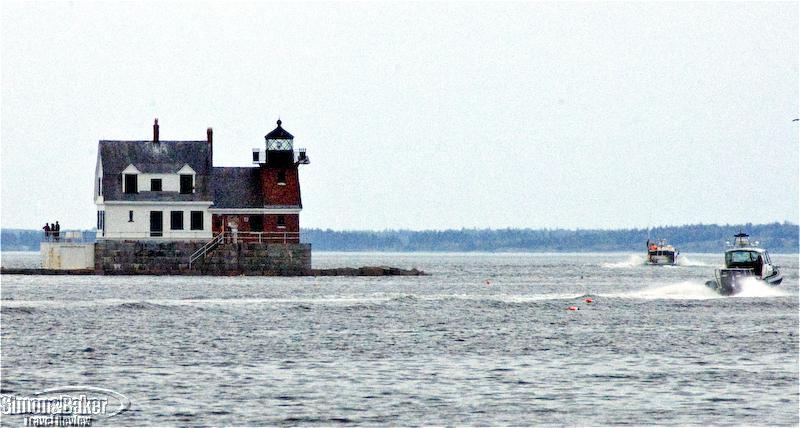
Originally settled in 1769 as a lumber camp, Rockland slowly developed with shipbuilding as its primary industry, before experiencing exponential growth in the latter part of the 19 th century due to its proximity to large limestone quarries. With the building boom of major United States cities fueling the demand for limestone to make mortar and cement, the city prospered as a lime processing and shipping center. Lime millionaires built superb Victorian manors that endured, placing today’s small town of 10,000 residents with 145 buildings on the National Register of Historical Places. Many of these homes have been meticulously maintained and restored, making the city’s back streets a virtual walking museum of Victorian architecture. Three of the grandest were turned into historic inns: the Berry Manor, the LimeRock and the Captain Lindsey House Inns. They have been impeccably restored to their original luxury to give guests a taste of the life of affluent 19 th century New England families (see separate stories).
The 20 th century was not as kind to Rockland as its predecessor. In the first half of the century, new construction methods sealed the demise of the limestone industry; then the fishing industry faltered. The city experienced several dark decades. Fortunately, the area had long been a summer favorite for a number of noted artists (including the Winslow Homer and later the Wyeth painting dynasty). It was the artistic community that provided the impetus for Rockland’s renaissance. Today, the city enjoys a vibrant year-round cultural life. It is home to more than 25 galleries and several museums that attract art-minded visitors who appreciate its balance between culture and casual small seaport atmosphere.
This rich creative environment has attracted a number of talented chefs who, using locally grown organic products and freshly harvested seafood, started working their own artistry in the kitchen. Rockland now boasts a variety of chef-owned restaurants, each reflecting the individuality of its owner. Their common thread is the quality of their menu and service. Whether on land or sea, or in the kitchen, the Rockland Renaissance was palpable everywhere but never more so than in the enthusiasm of the townspeople. Everyone I met was passionate about the town’s history and traditions, justifiably proud of its progress and eager to ensure that I experienced it all. I thoroughly loved my late summer visit to this dynamic small town by the sparkling waters of the Penobscot Bay. I will recommend it as a mandatory destination to any friend wishing to experience the unspoiled beauty of the northern New England coast.
Electrical Current 120 Volt
How To Get There Most major U.S. carriers, including American, Continental, Delta, United and Northwest Airlines provided daily scheduled flights with connections from most major U.S. cities to nearby airports: Boston Logan International Airport, Portland International Jetport and Bangor’s International Airport. From any of these airports, a good network of interstate and state highways easily led to Rockland.
Location At mid-point of Maine’s Atlantic coastline; 189 miles (305 kilometers) north of Boston, Massachusetts, 82 miles (130 kilometers) north of Portland, Maine and 42 miles (68 kilometers) east of the state capital, Augusta.
Technology High-speed internet connectivity was widely available. Cell phone reception was excellent wherever I went.
Time GMY/UTC minus five hours (e.g. U.S. Eastern Time)
Transportation With most tourist activities located within reasonable walking distance, the city was best experienced on foot. For visitors who preferred using their car, traffic was light and parking readily available.
For those interested in the history and lore of lighthouses, the Maine Lighthouse Museum, featured an extensive collection of Fresnel lenses used in lighthouses from the late 19 th to the mid-20 th century, many of them strikingly reminiscent of Art Deco works of art.
For art lovers, the Farnsworth Art Museum attracted visitors from around the world. Its permanent collection, “Maine in America,” featured renowned 18 th and 19 th century American artists such as Gilbert Stuart, Thomas Sully, Thomas Eakins, Eastman Johnson, Fitz Hugh Lane, Frank Benson, Childe Hassam and Maurice Prendergast. The museum also boasted one of the nation’s largest collections of works by 20 th century sculptor Louise Nevelson. Additionally, the Farnsworth Museum was home to the Wyeth Center, exclusively dedicated to the works of three generations of world-famous Wyeth artists, illustrator N.C., his son Andrew and grandson Jamie Wyeth.
Two miles South of Rockland, I found the Owl’s Head Transportation Museum well worth a visit. Located in a large hanger at the edge of the Knox County Regional Airport, it featured over 100 historic aircrafts, cars, carriages, motorcycles, bicycles and engines from the late 19 th to mid 20 th centuries.
Cost of visiting Reasonable
Reviewers Article and photos by Josette King
Would You Visit Again? Yes







